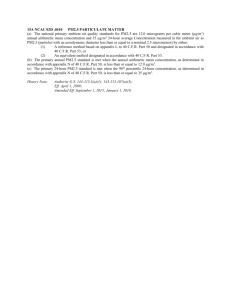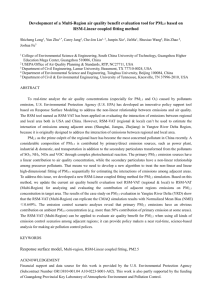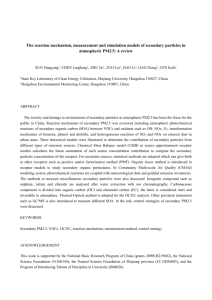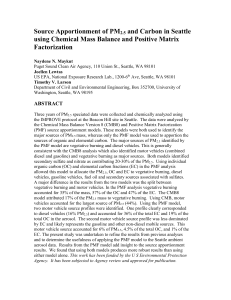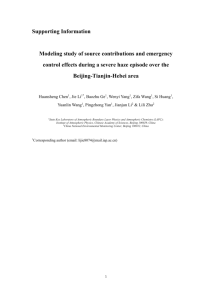Data supplement 1 - Occupational and Environmental Medicine
advertisement
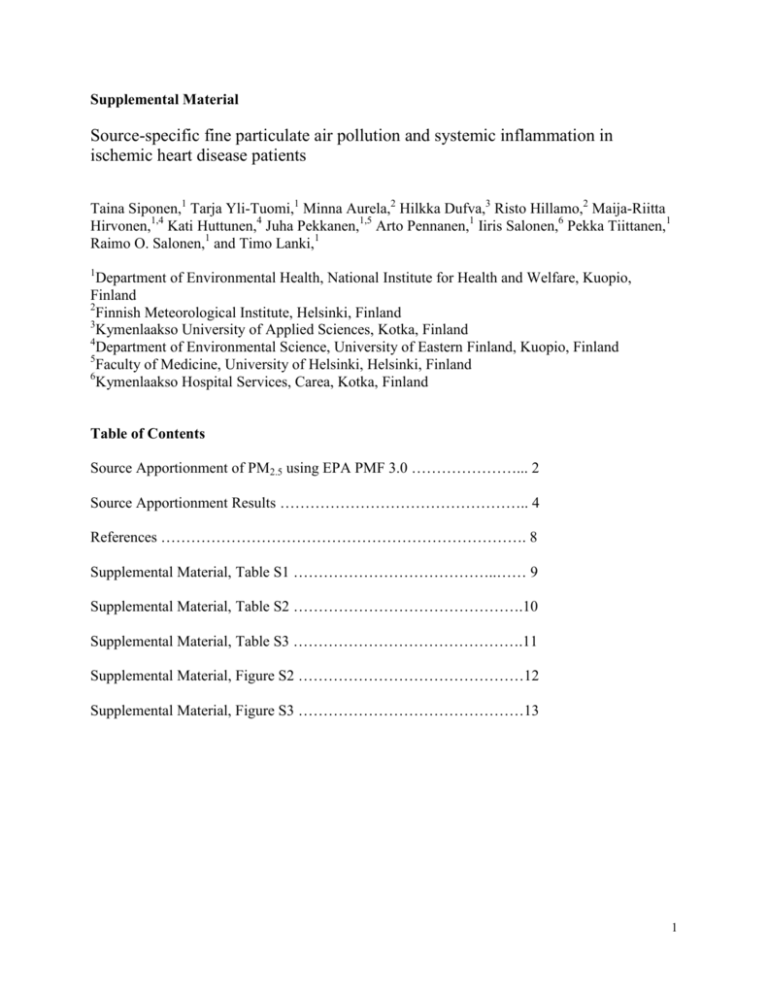
Supplemental Material Source-specific fine particulate air pollution and systemic inflammation in ischemic heart disease patients Taina Siponen,1 Tarja Yli-Tuomi,1 Minna Aurela,2 Hilkka Dufva,3 Risto Hillamo,2 Maija-Riitta Hirvonen,1,4 Kati Huttunen,4 Juha Pekkanen,1,5 Arto Pennanen,1 Iiris Salonen,6 Pekka Tiittanen,1 Raimo O. Salonen,1 and Timo Lanki,1 1 Department of Environmental Health, National Institute for Health and Welfare, Kuopio, Finland 2 Finnish Meteorological Institute, Helsinki, Finland 3 Kymenlaakso University of Applied Sciences, Kotka, Finland 4 Department of Environmental Science, University of Eastern Finland, Kuopio, Finland 5 Faculty of Medicine, University of Helsinki, Helsinki, Finland 6 Kymenlaakso Hospital Services, Carea, Kotka, Finland Table of Contents Source Apportionment of PM2.5 using EPA PMF 3.0 …………………... 2 Source Apportionment Results ………………………………………….. 4 References ………………………………………………………………. 8 Supplemental Material, Table S1 …………………………………..…… 9 Supplemental Material, Table S2 ……………………………………….10 Supplemental Material, Table S3 ……………………………………….11 Supplemental Material, Figure S2 ………………………………………12 Supplemental Material, Figure S3 ………………………………………13 1 Source Apportionment of PM2.5 using EPA PMF 3.0 We determined the sources of fine particles (PM2.5; particles with aerodynamic diameter less than 2.5 µm) by using U.S. Environmental Protection Agency’s model EPA PMF 3.0. PMF (Positive Matrix Factorization) is an advanced multivariate receptor modeling technique that calculates site-specific source profiles and source contributions (Paatero 1997). Investigators comparing results of several source apportionment methods, including PMF, concluded that the results were consistent across users and methods (Hopke et al. 2006). One benefit of PMF compared to other methods is point-by-point scaling of the data that enables PMF to handle missing and below-detection-limit data that commonly occur during environmental measurements. The U.S. EPA’s Office of Research and Development has developed a standalone graphical user interface (EPA PMF 3.0) that is freely distributed (Norris et al. 2008). EPA PMF 3.0 solves the general receptor model using constrained, weighted least-squares as implemented in the program ME2 (Multilinear Engine) (Paatero 1999). The mathematical equation for the model is P x ij g ip f pj e ij p 1 i 1,..., I j 1,..., J p 1,..., P (1) where xij is the jth species concentration measured in the ith sample, gip is the particulate mass concentration from the pth source contributing to the ith sample, fpj is the jth species mass fraction from the pth source, eij is residual associated with the jth species concentration measured in the ith sample, and P is the total number of independent sources. 2 The task of EPA PMF is to minimize the sum of squares P x g ip f pj ij I J p 1 Q σ ij i 1 j1 2 (2) The value σij is the uncertainty of the measured value xij. We constrained all sources to have non-negative species concentration, and allowed no sample to have negative source contribution. We operated the model in a robust mode so that for any data point for which the residual exceeded 4 times the error estimate, the value was processed as an extreme value and its weight was decreased. The use of point-by-point error estimates as the weight of the data points improves the fit since more accurate values get more weight than less accurate values. Thus, the accuracy depends on the analyzed species as well as on its concentration level. We determined the uncertainty as 2 MDL,if concentration MDL 2 percentage concentration (MDL) , if concentration MDL 2 (3) where MDL was the method detection limit. For ions and levoglucosan we used MDLs based on the chemical analysis. For other composition data, we estimated the values from the lowest reported concentrations. The percentage uncertainty consists of the analytical reproducibility and the modeling uncertainty. Modeling uncertainty is included, because data do not exactly meet the 3 modeling assumptions, namely the assumption that the ratios of species in each factor do not vary through time (Norris et al. 2008). We used 20 percent as the modeling uncertainty, which produced reasonable relative uncertainties for each dataset. We measured and collected PM2.5 samples at urban background station between 14 Nov 2005 and 21 Apr 2006. In the model, we used daily average concentrations of PM2.5, absorption coefficient (ABS), particle number concentration (PNC), as well as sodium (Na+), ammonium (NH4+), potassium (K+), magnesium (Mg2+), calcium (Ca2+), chlorine (Cl-), sulfate (SO42-) and oxalate ions, and levoglucosan. In addition, we utilized NO concentration measured at a nearby (450 m) municipal measurement site. Number of data points, geometric mean, geometric standard deviation, and MDL are presented in Table S1. In the data, we substituted missing values with geometric mean and weighted them down by four (σi=4σi). Source Apportionment Results We run the model with 4 to 10 factors from 100 random starting points. We regarded the five factor model as the best solution to interpret the likely sources. Correlation coefficients between source categories and the individual pollutants are presented in Table S2 (Supplemental Material, Table S2). The first factor contained high percentages of SO42- and NH4+ concentration (Supplemental Material, Figure S2). Also oxalate was associated with this factor. SO42- and NH4+ ions are common tracers of secondary aerosol PM, which is formed from inorganic and organic gaseous emissions during regional transport within hours or maybe one day or during long range transport (LRT) of air masses for hundreds of kilometers within some days. Oxalate can originate from primary emissions of biomass burning (Yamasoe et al. 2000) and/or be formed as 4 a secondary product by the oxidation of gaseous organic compounds (Kawamura and Ikushima 1993). The average source contribution of LRT to PM2.5 was 4.5 µg m-3 or 56% (Supplemental Material, Table S3). The highest concentrations took place between the end of February and midMarch (Supplemental Material, Figure S3). The factor describing traffic emissions was characterized by NO and PNC, and to lesser extend by Ca2+ and ABS (Supplemental Material, Figure S2). Emissions from gasoline and diesel powered vehicles could not be separated from each other on the daily level. Ca2+ indicates that also traffic induced road dust emission was included in this factor, in addition to the tailpipe exhaust emissions. Traffic emissions explained, on average, 8% of the PM2.5 mass (Supplemental Material, Table S3). Contribution of traffic emissions was higher during weekdays than weekends. The third factor explained 96% of the variation in levoglucosan concentration. Levoglucosan is a commonly used, specific and relatively stable organic chemical tracer for biomass combustion that is exclusively produced by thermal breakdown of cellulose and diverse hemicelluloses (Simoneit 2002). Other, non-specific tracers of biomass burning include black carbon and ions such as K+ from inorganic ash, and oxalate. In our data, also ABS and K+ were associated with this factor. Thus, this factor described PM2.5 emissions from biomass combustion. The average source contribution was 1.6 µg m-3 (20%) (Supplemental Material, Table S3). The fourth factor described the sea spray aerosols. It explained 90% of the variation in Clconcentration and the ratios of the sea salt components, i.e. Cl-, Na+, SO42-, Mg2+, K+ and Ca2+, were close to that in sea water. Sea salt particles were observed in Kotka when the air masses had passed over the Northern Atlantic before arriving to the measurement site (data not shown). 5 Almost 70% of the Na+ concentration and 20-30% of Ca2+, K+ and Mg2+ concentrations were associated with the fifth factor. The highest concentrations (Supplemental Material, Figure S3) were observed during northern winds and back trajectories arriving via south-east border of Finland (data not shown). There are several pulp mills in Kotka and near the border within 140 km from Kotka. All of these facilities used sulfate process for conversion of wood into wood pulp. The electric filters used to control the emissions enable high efficiency particulate removal, but some emissions of Na+, SO42- and Ca2+ (and K+) are possible (Wahlberg H, personal communication). Although the average PM2.5 concentration corresponding to this factor was low, levels as high as 4-6 µg/m³ were observed on some days. On average, PM2.5 components from pulp mills formed 13% (1.0 µg/m³) of the PM2.5 mass. Correlation between the measured PM2.5 and the sum of source-specific PM2.5 was very high (R2=0.95). Limitation in the source apportionment was the lack of daily concentrations of V and Ni, tracers for residual oil combustion emissions from port and ship traffic. The port of Kotka is a major sea port in Finland, and thus emissions from ships burning No. 6 fuel oil are likely to contribute to the urban PM2.5 concentration. According to the SPECIATE 3.2 speciation profile for uncontrolled residual oil combustion the weight fraction of Vanadium in PM2.5 is 3.44% (http://cfpub.epa.gov/si/speciate/ehpa_speciate_browse_details.cfm?ptype=PD&pnumber=13501 2.5, 8.8.2014). In Kotka, V and Ni, among other metals, were analyzed from four-day (from Monday to Friday) samples collected with virtual impactor. The average V concentration was 5.0 µg/m³ while Ni concentrations were mainly below the quantification limit. Based on V concentration, a rough estimation on contribution of ship emission to PM2.5 in Kotka is 0.1 6 µg/m³. Without the tracer elements, these emissions are likely to be combined with traffic emissions, the other local fossil fuel combustion source. Daily concentrations of tracers for airborne soil (Si, Al, Fe) were not available. However, during the cold season, contribution of airborne soil can be estimated to be low. Aurela et al (2010) reported that based on chemical mass closure of four-day samples, soil-derived material accounted for 3% ± 2 % of the PM2.5 mass in Kotka. The model was stable and the identified source categories are known to be present in Kotka. Furthermore, the composition and temporal variation of the factors were physically reasonable. Addition of data on metal and organic marker species would enable separation of other minor sources. 7 References Hopke PK, Ito K, Mar TF, et al. 2006. PM source apportionment and health effects: 1. Intercomparison of source apportionment results. J Expo Sci Environ Epidemiol 16:275–86. Kawamura K, Ikushima K. 1993. Seasonal changes in the distribution of dicarboxylic acids in the urban atmosphere. Environ Sci Technol 27:2227-2235. Norris G, Vedantham R, Wade K, et al. 2008. EPA Positive Matrix Factorization (PMF) 3.0 Fundamentals & User Guide. U.S. Environmental Protections Agency EPA 600/R-08/108. Available: http://www.epa.gov/heasd/products/pmf/EPA PMF 3.0 User Guide v16_092208_final.pdf [accessed 30 January 2013]. Paatero P. 1997.Least squares formulation of robust non-negative factor analysis. Chemom Intell Lab Syst 37:23-35. Paatero P 1999. The multilinear engine - A table-driven, least squares program for solving multilinear problems, including the n-way parallel factor analysis model. J Comput Graph Stat 8:854-88. Simoneit BRT. 2002. Biomass burning — a review of organic tracers for smoke from incomplete combustion. Appl Geochem 17:129–162. Yamasoe MA, Artaxo P, Miguel AH, et al. 2000. Chemical composition of aerosol particles from direct emissions of vegetation fires in the Amazon Basin: water-soluble species and trace elements. Atmos Environ 34:1641–1653. 8 Supplemental Material, Table S1. The number of data points above minimum detection limit (MDL), geometric mean (GM), geometric standard deviation (GSD), and MDL for variables used in the present source apportionment model. N GM GSD MDL UNIT PM2.5 130 7.5 2.1 0.5 µg m-3 ABS 128 1.3 1.9 0.1 10-5 m-1 NO 115 18 1.7 1.0 µg m-3 PNC 128 5284 2.0 500 cm-3 Na+ 130 109 2.1 2.0 ng m-3 NH4+ 130 561 2.6 2.0 ng m-3 K+ 130 63 2.2 2.0 ng m-3 Mg2+ 130 6.4 2.1 2.0 ng m-3 Ca2+ 130 23 2.0 2.0 ng m-3 Cl- 130 16 3.1 2.0 ng m-3 SO42- 130 1883 2.2 2.0 ng m-3 Oxalate 130 31 2.9 1.0 ng m-3 Levoglucosan 123 29 3.1 1.0 ng m-3 PM2.5 = particles less than 2.5 µm in aerodynamic diameter; ABS=absorption coefficient PNC = particle number concentration 9 Supplemental Material, Table S2. Correlation coefficients between source categories and the individual pollutants. Pulp LRT Traffic Biomass Sea salt mills ABS 0.57 0.41 0.80 -0.31 0.35 NO 0.33 0.66 0.47 -0.05 0.25 PNC 0.21 0.62 0.14 -0.17 0.25 + Na -0.04 0.04 0.02 0.39 0.82 NH4+ 0.97 0.12 0.64 -0.37 0.14 K+ 0.53 0.25 0.73 -0.21 0.54 Mg2+ -0.26 -0.16 -0.16 0.67 0.23 Ca2+ 0.15 0.45 0.34 -0.01 0.70 - -0.39 -0.08 -0.18 1.00 -0.06 SO42- 0.88 0.06 0.53 -0.38 0.23 Oxalate 0.77 0.01 0.70 -0.35 0.01 Levoglucosan 0.58 0.15 0.97 -0.20 0.18 Cl ABS=absorption coefficient PNC = particle number concentration 10 Supplemental Material, Table S3. The average mass contributions of identified sources to PM2.5 mass. LRT Traffic emissions Biomass burning Sea salt Pulp mills PM2.5 PM2.5 (µg m-3) 4.5 0.6 1.6 0.1 1.0 % 56 8 20 1 13 PM2.5 = particles less than 2.5 µm in aerodynamic diameter; LRT = regional and long range transport 11 10000 100 % 80 % 100 60 % 10 40 % 1 20 % 60 % 10 40 % 1 20 % 100 % 80 % 60 % 40 % 1 20 % 80 % 60 % 10 40 % 1 Levogluc. SO4 Cl Ca Mg K NH4 Na PNC NO Pulp mills Oxalate 100 ABS 0.1 1000 20 % 0% 100 % 80 % 60 % 10 40 % 1 20 % Levogluc. Oxalate SO4 Cl Ca Mg K NH4 Na PNC NO 0% ABS 0.1 % of Species 100 % % of Species Levogluc. 100 Oxalate SO4 Cl Ca Mg K Na NH4 Sea salt PNC NO 1000 0% ABS 0.1 % of Species 10 Levogluc. SO4 Cl Ca Mg K NH4 Na PNC NO Biomass burning Oxalate Conc. Of Species 0% ABS 0.1 Conc. Of Species 80 % 100 100 Conc. Of Species 100 % % of Species 1000 Levogluc. SO4 Cl Ca Mg K NH4 Na PNC Traffic NO 0% Oxalate Conc. Of Species 0.1 10000 % of Species 1000 ABS Conc. Of Species LRT Supplemental Material, Figure S2. Factor profiles in Kotka. Columns = concentrations of species (units in table S1); * = relative contribution of resolved factors to chemical species (%). (LRT = regional and long range transport) 12 PM2.5 (µg/m³) PM2.5 (µg/m³) PM2.5 (µg/m³) 4 2 0 2 1 0 8 6 Pulp mills 30.1.06 6.2.06 5.12.05 12.12.05 19.12.05 26.12.05 2.1.06 9.1.06 16.1.06 23.1.06 30.1.06 12.12.05 19.12.05 26.12.05 2.1.06 9.1.06 16.1.06 23.1.06 30.1.06 20.3.06 27.3.06 3.4.06 10.4.06 17.4.06 24.4.06 20.3.06 27.3.06 3.4.06 10.4.06 17.4.06 24.4.06 6.3.06 6.3.06 13.3.06 6.3.06 27.2.06 27.2.06 13.3.06 27.2.06 20.2.06 20.2.06 24.4.06 17.4.06 10.4.06 3.4.06 27.3.06 20.3.06 13.3.06 20.2.06 13.2.06 6.2.06 13.2.06 6.2.06 13.2.06 23.1.06 16.1.06 9.1.06 2.1.06 26.12.05 19.12.05 12.12.05 5.12.05 28.11.05 28.11.05 0 5.12.05 2 28.11.05 4 21.11.05 24.4.06 17.4.06 10.4.06 3.4.06 27.3.06 20.3.06 13.3.06 6.3.06 27.2.06 20.2.06 13.2.06 6.2.06 30.1.06 23.1.06 16.1.06 9.1.06 2.1.06 26.12.05 19.12.05 12.12.05 5.12.05 28.11.05 24.4.06 17.4.06 10.4.06 3.4.06 27.3.06 20.3.06 13.3.06 6.3.06 27.2.06 20.2.06 13.2.06 6.2.06 30.1.06 23.1.06 16.1.06 9.1.06 2.1.06 26.12.05 19.12.05 12.12.05 5.12.05 28.11.05 21.11.05 Sea salt 21.11.05 Biomass burning 21.11.05 14.11.05 6 14.11.05 0 8 14.11.05 1 Traffic 14.11.05 0 2 21.11.05 14.11.05 PM2.5 (µg/m³) PM2.5 (µg/m³) 20 15 LRT 10 5 Supplemental Material, Figure S3. Source-specific contributions to daily PM2.5 in Kotka. (LRT = regional and long range transport) 13 LRT TRAF BIOM SALT IND Supplemental material, Figure S4 Estimated effect of 5-day average source-specific PM2.5 (particles smaller than 2.5 µm in aerodynamic diameter) on interleukin-12 (IL-12) and C-reactive protein (CRP). Effect estimates have been calculated as percent changes of the outcome mean per interquartile increase in air pollution concentration together with 95-% confidence intervals. (LRT = regional and long-range transport; TRAF = traffic emissions; BIOM = biomass combustion; SALT = sea salt; IND = pulp industry).
